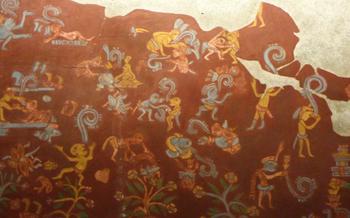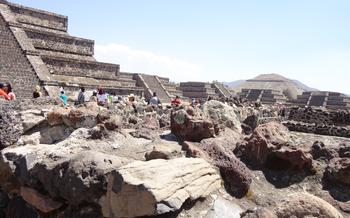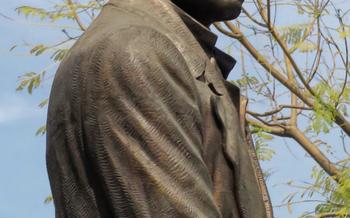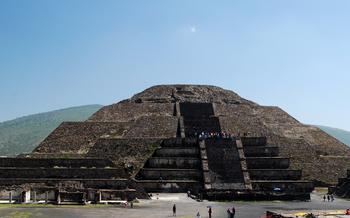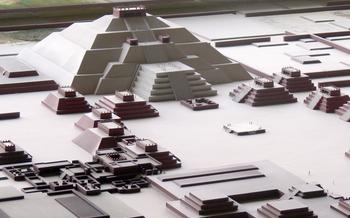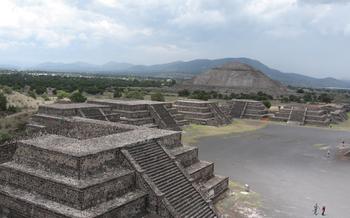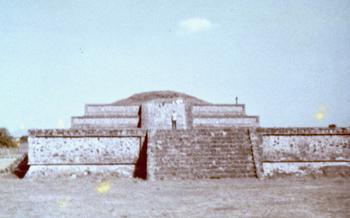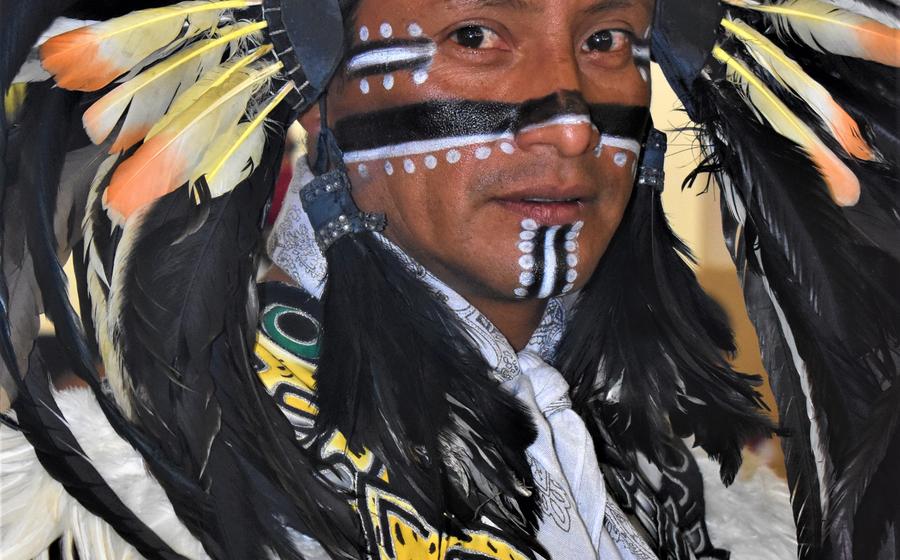
Soumaya Museum
- Teotihuacan: A Journey to the Past
- Museo Soumaya: A Treasure Trove of Art
- Marveling at the Pyramid of the Moon
- Strolling the Avenue of the Dead
- Discovering the Palace of Quetzalpapalotl
- Visiting the Temple of Quetzalcoatl
- Exploring the Museum of Teotihuacan Culture
- Shopping for Souvenirs in Teotihuacan
- Dining in Teotihuacan
- Attending a Cultural Event or Festival
- Taking a Guided Tour
- Planning Your Visit
- Staying Safe in Teotihuacan
- Insider Tips and Unique Experiences
Teotihuacan: A Journey to the Past
Teotihuacan, an ancient city located just northeast of Mexico City, is a testament to the ingenuity and architectural prowess of Mesoamerican civilizations. Its name, meaning "The Place Where Gods Were Created," hints at the city's profound religious significance. Legends abound about its origins, with one tale attributing its creation to the gods themselves, who descended from the heavens to build a city that would connect the earthly and spiritual realms. Another legend speaks of a giant who, in a fit of rage, threw rocks that formed the city's famous pyramids.
Teotihuacan flourished between 100 BC and 750 AD, reaching its peak around 500 AD when it was home to an estimated 200,000 people. The city's influence extended far beyond its physical borders, with its culture and art leaving an indelible mark on Mesoamerica.
Planning a visit to Teotihuacan is relatively straightforward. The city is easily accessible from Mexico City, with regular buses and guided tours available. It's advisable to start your exploration early in the morning to avoid the midday heat and crowds. Comfortable shoes are a must, as you'll be doing a lot of walking on uneven terrain. And don't forget your camera to capture the awe-inspiring sights that await you.
Museo Soumaya: A Treasure Trove of Art
The Museo Soumaya is a must-visit for any art lover visiting Teotihuacan. The museum houses a vast and impressive collection of over 66,000 artworks, spanning from pre-Columbian to contemporary pieces. The collection includes works by renowned Mexican artists such as Diego Rivera, Frida Kahlo, and José Clemente Orozco, as well as European masters like Rodin, Dalí, and Monet.
One of the highlights of the museum is the collection of pre-Columbian art, which features intricate sculptures, ceramics, and jewelry from various ancient Mexican cultures, including the Aztecs, Mayans, and Olmecs. The museum also boasts a significant collection of European art, with works from the Renaissance to the modern era, including paintings, sculptures, and decorative arts.
The Museo Soumaya is housed in a striking modern building designed by Mexican architect Fernando Romero. The building's unique design, with its curved walls and reflective surfaces, has become an iconic landmark in Teotihuacan. The museum's interior is equally impressive, with spacious galleries and state-of-the-art exhibition spaces that showcase the artworks to their fullest potential.
Behind the scenes, the Museo Soumaya has a fascinating history. The museum was founded by Carlos Slim Helú, one of the wealthiest men in the world, who has been passionate about collecting art since his youth. The museum's collection has grown significantly over the years, and it continues to expand with new acquisitions.
The Museo Soumaya is a true gem, offering visitors a chance to explore a diverse range of art from around the world. Whether you are interested in pre-Columbian, European, or contemporary art, you are sure to find something to admire and appreciate at this world-class museum.
Marveling at the Pyramid of the Moon
Slightly smaller but equally impressive, the Pyramid of the Moon stands as a testament to the architectural prowess of the ancient Teotihuacans. Its imposing structure rises from the heart of the city, beckoning visitors to explore its secrets.
At the base of the pyramid lies the Temple of the Feathered Serpent, a sacred site adorned with intricate carvings and sculptures. This temple served as a place of worship for the city's inhabitants, who revered Quetzalcoatl, the feathered serpent god.
The Pyramid of the Moon held great religious significance in ancient Teotihuacan society. It was believed to be a portal to the underworld, and its alignment with the stars during certain times of the year was seen as a sign of divine communication.
Personal Anecdotes:
My first encounter with the Pyramid of the Moon was a breathtaking experience. As I approached the colossal structure, I felt a sense of awe and wonder wash over me. The pyramid's sheer size and imposing presence were truly humbling.
Climbing the steep steps of the pyramid was a challenging but rewarding experience. Each step brought me closer to the summit, where I was rewarded with panoramic views of the ancient city. The surrounding landscape stretched out before me, dotted with temples, platforms, and the distant Pyramid of the Sun.
Inside the pyramid, I explored a network of tunnels and chambers that had been carved into the rock. These spaces were once used for religious ceremonies and rituals, and the air still seemed to carry an aura of spirituality.
My visit to the Pyramid of the Moon was a profound experience that deepened my understanding of ancient Teotihuacan culture. This magnificent structure stands as a testament to the ingenuity and devotion of a people who once thrived in this sacred city.
Strolling the Avenue of the Dead
Running through the heart of ancient Teotihuacan, the Avenue of the Dead was once a bustling thoroughfare teeming with life. Today, visitors can walk along this 2-mile-long stretch, marveling at the impressive ruins that flank its sides.
Along the Avenue of the Dead, you'll encounter a series of temples, platforms, and other structures, each with its own unique history and significance. The most notable of these are the Pyramid of the Sun, the Pyramid of the Moon, and the Temple of Quetzalcoatl.
Take your time exploring the Avenue of the Dead, soaking in the atmosphere and imagining what life was like in this ancient city. Be sure to climb to the top of the Pyramid of the Sun for breathtaking views of the surrounding landscape.
Personal Anecdote:
As I strolled along the Avenue of the Dead, I couldn't help but feel a sense of awe at the sheer scale and grandeur of the ancient city. The towering pyramids, the intricate carvings, and the sheer number of structures were simply overwhelming. It was easy to see why Teotihuacan was once one of the most powerful and influential cities in Mesoamerica.
Discovering the Palace of Quetzalpapalotl
Among the ruins of Teotihuacan, the Palace of Quetzalpapalotl stands out for its intricate architecture and historical significance. Named after the feathered butterfly goddess, the palace was once the residence of high-ranking officials or priests.
Exploring the palace, you'll be awe-inspired by its well-preserved murals and sculptures, depicting scenes from daily life and religious ceremonies. The Patio of the Butterflies is a particular highlight, showcasing a stunning array of butterfly motifs.
One fascinating feature of the palace is its underground chambers. Descending into these chambers feels like stepping back in time, as you encounter ancient water cisterns and storage rooms, offering a glimpse into the palace's inner workings.
As you wander through the palace, imagine the bustling activity that once filled its courtyards and rooms. The Palace of Quetzalpapalotl serves as a testament to the artistry and ingenuity of the Teotihuacan people, leaving visitors with a profound appreciation for their rich cultural heritage.
Personal anecdote:
During my visit to the Palace of Quetzalpapalotl, I was struck by the intricate details of the murals. In one particular mural, I noticed a depiction of a feathered serpent emerging from a flower. This image resonated with me deeply, as it symbolized the interconnectedness of nature and spirituality in Teotihuacan culture.
Visiting the Temple of Quetzalcoatl
Among the many impressive structures in Teotihuacan, the Temple of Quetzalcoatl stands out for its intricate carvings and vibrant colors. Dedicated to the feathered serpent god, Quetzalcoatl, this temple is a testament to the artistic and religious prowess of the ancient Teotihuacans.
As you approach the temple, you'll be awestruck by its towering presence. The pyramid-shaped structure is adorned with intricate carvings depicting Quetzalcoatl and other deities. The facade of the temple is particularly impressive, featuring a series of feathered serpent heads that seem to emerge from the stone.
Take your time to explore the temple's exterior, admiring the intricate details and symbolism. Once you've had your fill, head inside to discover the temple's inner sanctum. The interior is relatively small, but it's worth exploring to get a sense of the temple's religious significance.
The Temple of Quetzalcoatl is one of the most important religious sites in Teotihuacan, and it played a crucial role in the city's rituals and ceremonies. It's a must-see for anyone interested in the history and culture of this ancient civilization.
Personal anecdote:
During my visit to the Temple of Quetzalcoatl, I was struck by the incredible craftsmanship and artistry on display. The carvings were so intricate and detailed that it was hard to believe they were created without modern tools. I spent a long time examining the temple's facade, trying to take in all the details.
Inside the temple, I was surprised by how small and dark it was. It was a stark contrast to the bright and airy exterior. However, the dimly lit interior added to the temple's mystique and made it feel like a sacred space.
I left the Temple of Quetzalcoatl feeling inspired and amazed. It was a reminder of the incredible achievements of the ancient Teotihuacans and their deep connection to the divine.
Exploring the Museum of Teotihuacan Culture
The Museum of Teotihuacan Culture is a treasure trove of artifacts that offer a glimpse into the rich history and culture of this ancient city. Located just a short walk from the Pyramid of the Sun, the museum houses a vast collection of objects excavated from Teotihuacan and its surrounding areas.
Highlights of the Collection
Among the highlights of the museum's collection are elaborate stone carvings, pottery, and jewelry. The stone carvings include intricate masks, sculptures of gods and goddesses, and architectural fragments from the city's temples and palaces. The pottery collection is equally impressive, featuring a wide variety of vessels, from simple bowls and plates to elaborately decorated vases and figurines. The jewelry collection includes necklaces, earrings, bracelets, and rings made from a variety of materials, including gold, silver, and turquoise.
Preserving and Promoting Teotihuacan's Heritage
The Museum of Teotihuacan Culture plays a crucial role in preserving and promoting the cultural heritage of this ancient city. Through its exhibits and educational programs, the museum helps to raise awareness of the importance of Teotihuacan and its contributions to Mesoamerican civilization. The museum also works to protect and conserve the city's archaeological sites and artifacts, ensuring that they are preserved for future generations.
Anecdotes
My personal anecdotes about visiting the Museum of Teotihuacan Culture are many, on my first visit I was amazed by the sheer size and variety of the collection. I spent hours wandering through the exhibits, marveling at the intricate carvings and the delicate pottery. On a subsequent visit, I took part in one of the museum's educational programs, which gave me a deeper understanding of the history and culture of Teotihuacan. I highly recommend a visit to the Museum of Teotihuacan Culture to anyone interested in learning more about this fascinating ancient city.
Shopping for Souvenirs in Teotihuacan
Teotihuacan is a treasure trove of unique and authentic souvenirs that can serve as lasting mementos of your visit to this ancient city. From intricately painted pottery and colorful hand-woven textiles to shimmering jewelry and intricately carved wooden figurines, there's something for every taste and budget.
When shopping for souvenirs in Teotihuacan, be sure to visit the local markets, where you'll find a wide variety of handmade goods at reasonable prices. The Mercado de Artesanías de Teotihuacan, located near the Pyramid of the Sun, is a particularly good place to start your shopping adventure.
If you're looking for high-quality pottery, be sure to check out the work of local artisans such as María del Carmen Hernández, whose beautifully painted pots and vases are a testament to the enduring traditions of Teotihuacan craftsmanship. For unique and colorful textiles, visit the shop of Juana López, where you'll find hand-woven rugs, blankets, and shawls in a variety of traditional designs.
Jewelry lovers will delight in the silver and gemstone creations of local artisans like Pedro Martínez, whose intricate necklaces, earrings, and bracelets are inspired by ancient Teotihuacan motifs. And if you're looking for something truly unique, be sure to visit the woodcarving workshop of Pablo García, where you'll find stunningly carved wooden figurines, masks, and other decorative items.
When shopping in Teotihuacan, don't be afraid to bargain for a good price. It's customary to haggle with vendors, and you can often get a significant discount if you're willing to negotiate. Just be sure to do so respectfully and with a smile.
No matter what you choose to buy, be sure to inspect each item carefully before making a purchase. This will help you avoid buying low-quality souvenirs and ensure that you're getting a fair price for your money. With a little time and effort, you're sure to find the perfect souvenirs to commemorate your trip to this ancient and fascinating city.
Dining in Teotihuacan
Teotihuacan offers a delightful culinary experience for food enthusiasts and adventurers seeking authentic Mexican flavors. Indulge in traditional barbacoa, a slow-cooked lamb or goat dish that originated in the region. Savor the succulent nopales, grilled cactus paddles, and pulque, a traditional fermented beverage made from the sap of the maguey plant. Vegetarian and vegan options are also available, featuring fresh produce, beans, and flavorful sauces. Don't miss the opportunity to try the local street food, where you can find delicious tacos, tamales, and quesadillas. Embrace the vibrant food culture of Teotihuacan and create unforgettable culinary memories.
Personal anecdote:
On my visit to Teotihuacan, I stumbled upon a small, family-run restaurant that served mouthwatering barbacoa. The lamb was tender and juicy, cooked to perfection in a traditional underground oven. The nopales were grilled to a smoky perfection, and the pulque had a refreshing, slightly sweet flavor. The meal was a true testament to the culinary heritage of Teotihuacan, and I highly recommend seeking out similar local gems to experience the authentic flavors of the region.
Attending a Cultural Event or Festival
Teotihuacan is not just about ancient ruins and museums; it's also a vibrant cultural hub that hosts several annual events and festivals. If you're lucky enough to visit during one of these events, you'll be treated to a unique and unforgettable experience.
One of the most popular events is the Festival of San Juan Bautista, held every June 24th. This festival celebrates the patron saint of Teotihuacan with colorful processions, traditional dances, and live music. The streets come alive with food stalls, artisans selling their wares, and locals dressed in traditional costumes.
Another must-see event is the Day of the Dead (Día de los Muertos), which takes place on November 1st and 2nd. During this time, Teotihuacan transforms into a realm of vibrant colors and decorations as locals honor their deceased loved ones. You'll witness colorful altars, parades, and traditional rituals that pay homage to the departed.
To plan your trip around a cultural event or festival, check the official Teotihuacan tourism website for the latest schedule and information. You can also inquire at your hotel or hostel about upcoming events. Remember to book your accommodation and transportation in advance, as these events attract large crowds.
Personal Anecdote:
I had the privilege of attending the Festival of San Juan Bautista during my visit to Teotihuacan. The streets were teeming with locals and tourists alike, all dressed in their finest traditional attire. I was swept away by the infectious energy of the crowd as I watched colorful processions, listened to lively music, and tasted delicious local delicacies. It was a truly immersive experience that gave me a deeper appreciation for Teotihuacan's rich cultural heritage.
Taking a Guided Tour
When visiting Teotihuacan, taking a guided tour offers a plethora of benefits. Knowledgeable guides provide in-depth insights into the city's history, culture, and significance, enhancing your understanding of this ancient metropolis. Guided tours often include transportation to and from Mexico City, ensuring a hassle-free experience.
Choosing a reputable tour operator is crucial. Look for companies with experienced guides, positive reviews, and a good track record. It's advisable to book your tour in advance, especially during peak season, to avoid disappointment.
Guided tours typically cover the main attractions of Teotihuacan, including the Pyramids of the Sun and the Moon, the Avenue of the Dead, and the Temple of Quetzalcoatl. Tours often include visits to lesser-known sites, such as the Palace of Quetzalpapalotl or the Museum of Teotihuacan Culture, offering a more comprehensive exploration of the city.
My personal experience with a guided tour of Teotihuacan was exceptional. Our guide, a passionate archaeologist, brought the city's history to life with his engaging storytelling and expertise. He pointed out intricate details and shared fascinating anecdotes, making the tour both informative and enjoyable. Moreover, the tour allowed me to maximize my time, ensuring I saw all the must-see attractions without missing any hidden gems.
Planning Your Visit
Timing is crucial when planning a trip to Teotihuacan. For the best weather and fewer crowds, visit during the shoulder seasons (April-May and September-October). Avoid the summer months (June-August) when temperatures soar and crowds are at their peak.
Pack light clothing and comfortable shoes for exploring the pyramids and the Avenue of the Dead. Don't forget a hat, sunglasses, and sunscreen to protect yourself from the sun. If visiting during the rainy season (June-September), pack a raincoat or umbrella.
Getting to Teotihuacan from Mexico City is easy. Take the subway to the Autobuses del Norte bus station and catch a bus to Teotihuacan. The journey takes about an hour and costs around $
Once in Teotihuacan, you can explore the site at your own pace or join a guided tour. Guided tours are a great option if you want to learn more about the history and significance of the site. Tours typically last around two hours and cost between $20 and $30.
Whether you choose to explore Teotihuacan independently or with a guide, make sure to plan your visit carefully to make the most of your time.
Staying Safe in Teotihuacan
Teotihuacan is generally a safe place to visit, but like any tourist destination, it's important to be aware of potential risks and take necessary precautions. Here are some safety tips to keep in mind:
- Be aware of your surroundings and avoid walking alone at night, especially in secluded areas.
- Keep valuables such as jewelry, cash, and credit cards hidden and secure.
- Be cautious of pickpockets, particularly in crowded areas such as the pyramids and the Avenue of the Dead.
- Don't accept food or drinks from strangers, as they may be drugged.
- Be wary of touts and vendors who may be pushy or aggressive.
- Stay hydrated by drinking plenty of water, especially during the hot summer months.
- Wear comfortable shoes for walking on uneven surfaces and climbing the pyramids.
- Respect the local culture and customs, and dress appropriately when visiting religious sites.
- If you're feeling unwell or have any concerns, don't hesitate to ask for help from the local authorities or your tour guide.
By following these safety tips, you can help ensure that your visit to Teotihuacan is a safe and enjoyable one.
Insider Tips and Unique Experiences
As you wander through the ancient city of Teotihuacan, keep an eye out for the hidden gem known as the Cueva de la Bruja, or the Witch's Cave. Located near the Pyramid of the Sun, this small cave is adorned with colorful murals depicting various scenes from Teotihuacan life. It's a fascinating glimpse into the everyday lives of the city's inhabitants.
To make the most of your visit to the Soumaya Museum, consider booking a guided tour. The knowledgeable guides can provide insights into the history and significance of the artworks on display, enhancing your appreciation of the museum's collection.
Don't miss the opportunity to experience the spectacular views from the top of Cerro Gordo, a hill located just a short distance from the pyramids. Hike to the summit and be rewarded with breathtaking panoramic vistas of the entire archaeological site.
For a truly unforgettable experience, visit Teotihuacan during the equinoxes in March and September. During these special times of the year, the sun aligns perfectly with the Avenue of the Dead, creating a mesmerizing effect as it illuminates the pyramids and temples.

